
Call to arms
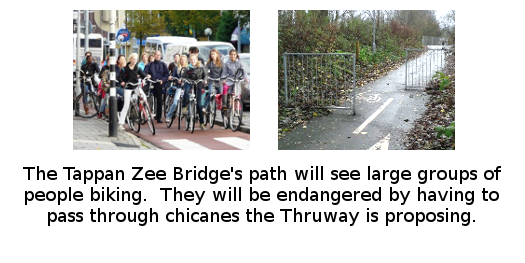
Polite Infographic to convey problem to politicians.
The new Tappan Zee Bridge (officially the Governor Mario M. Cuomo Bridge) will have a fantastic "Shared Use Path" for people walking, biking, etc. Unfortunately, the State's plan is unsafe and includes closing the path overnight.
14 organizations came together to convey the problems and solutions to the Governor (letter below).
April 4, 2018
To: Andrew Cuomo
Cc: Ali Chaudhry <ali.chaudhry@exec.ny.gov>,
Joanne Mahoney <joanne.mahoney@thruway.ny.gov>,
Jamey Barbas <jamey.barbas@newnybridge.com>,
George Paschalis <george.paschalis@newnybridge.com>
Thank you for having Ms. Barbas of the New NY Bridge Project write us on March 5 regarding the Shared Use Path (SUP). We appreciate the work to improve the path's safety and accessibility. It is welcome news that the latest plans remove swing gates, switch dismount signs to yield signs and improve warning signs for people driving.
Continuing our collaboration to make the bridge an exemplary, safe active transportation facility, we offer the following insights for consideration. Below is a summary. Further details are attached.
Safe systems account for how people actually behave instead of how we think people should behave.
These concepts will create safe interactions, obviating the need for chicanes added in the latest plan. Chicanes would dangerously hinder flow on a path already below FHWA's width standards.
Communities on both sides of the Bridge are working to increase cycling for transport via a large safe cycling network. A transportation system only gains acceptance if users can access it whenever needed. Thus the SUP must be operated like a road, only closing when absolutely necessary.
Thank you again for the update and open mindedness. Please have staff contact us for any clarifications or assistance needed, particularly the State Police while determining 24/7 access.
Sincerely,
 |
Daniel Convissor Bike Tarrytown |
 |
Bob Hermann Westchester Cycle Club |
 |
Ken McLeod League of American Bicyclists |
 |
Ian Thomas America Walks |
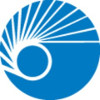 |
Virginia Sullivan Adventure Cycling Association |
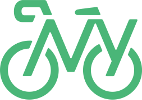 |
Kenneth Podziba Bike New York |
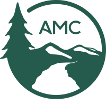 |
Ed Sobin Appalachian Mountain Club NY / NJ |
 |
Christy Guzzetta New York Cycle Club |
 |
Cyndi Steiner New Jersey Bike & Walk Coalition |
 |
Steve Vaccaro Five Boro Bicycle Club |
 |
Edith M Prentiss Disabled In Action of Metro NY |
 |
Emily Flynn Bike Friendly Kingston |
 |
Michael Reade Wallkill Valley Rail Trail Association |
 |
Neile Weissman Complete George |
When contemplating how to design SUP elements, think of a group ride of 20 people coming off the bridge while another group ride of 20 people is coming on. Add to that a family on bikes and a family walking. All at the same time.
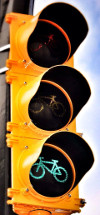
Traffic signals for bicycles
Giving everyone full consideration makes people feel the system is working for them, so they will be more likely to follow the rules -- enhancing safety.
For example, Chicago found that adding protected bike lanes, bicycle heads to the traffic signals and automatically sensing bikes boosted red light compliance to 81% by people on bikes -- up from 31% in the old system. (Case Study: Dearborn Street, Chicago, NACTO)
Intersection signaling that serves all modes with limited wait times improves safety. The Clinton Ave / Franklin St intersection and signal should:
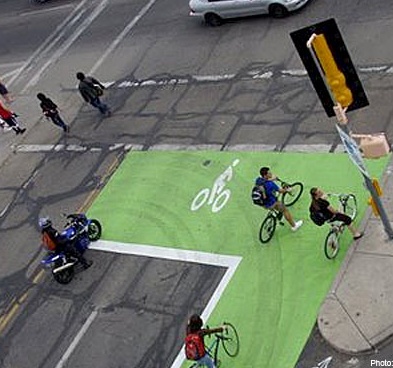
"Bike Box"
See the "Signalization Strategies" section of FHWA's "Separated Bike Lane Planning and Design Guide."

The system above makes the rules easy to obey. It encourages everyone to adhere to signals, helps moderate speeds of people driving into the intersection and neighborhood from the highways. Meeting safety goals this way obviates the need for chicanes.
Cycling is quite safe due to low mass and low speeds. Chicanes will force people to change velocity and course -- generating rear end, wheel overlap, side swipe, fall over and head on crashes. So chicanes would wind up creating danger where it didn't exist before.
These conflicts will be significant given the chicanes would narrow a path that will already be below FHWA's width guidelines. The Side Path without chicanes will be only 10' wide. The path will easily see more than 150 users / hour / direction, for which FHWA recommends paths be 12 - 14' wide. (p 4-5, Small Town and Rural Multimodal Networks, FHWA, 2016)
Reflecting again on effective rules, Ms. Barbas mentioned "cyclists will be advised to walk their bikes." Unreasonable requests will reduce overall compliance with the intersection's safety systems. It will be wise to set up the area so people can easily and safely ride on and off in an orderly manner.
The present design has just one curb ramp on the Side Path's half of the corner. (The Esposito Trail half of the corner has another curb ramp.) The number of people that will be cycling through this location means many will remain in the intersection after the signal changes. Another ramp is required. A western ramp to for people entering the Side Path, a middle ramp for people the exiting Side Path and an eastern ramp to serve the Esposito Trail.
The drawings still lack NYS DOT's "Narrow Lane Assembly" signs. They are applicable here due to street widths. They are are also required where Shared Lane Markings (sharrows) are used, per NYS DOT TSMI 13-07.
The "Turning Vehicle Yield" signs need bicycle icons added to them. Those, and the "Trail Crossing" signs seem to be needed for other directions as well.
In your research of access hours for similar facilities, it is important to focus on areas with high bicycle use, like the Netherlands. Having good, accessible infrastructure leads to more people cycling for transportation, which is what communities surrounding the Bridge are working toward.
The bike lanes sought by the Route 9, Route 119, Nyack and Orangetown studies, combined with the Cuomo Bridge, will produce a large, safe cycling network. A transportation system only gains acceptance if users can access it whenever needed. Being open 24/7 makes biking viable for commuting and evening activities (Tarrytown Music Hall, restaurants/bars in Nyack and Tarrytown).
The main "neighborhood concern" stems from fear of the unknown. Those concerns can be allayed by real-world experience from around the globe. People biking in the middle of the night are quietly going places without incident.
NYC and MTA bridges are open all night. Aside from the Brooklyn Bridge, NYPD does not patrol them on any regular basis. Crime, suicides and noise are not problems. Nearby residents are fine.
Some are wary of the path's lighting. Systems exist to turn on lights only when people are present.
When the Thruway fixes the highway, a Maintenance and Protection of Traffic plan is produced for the work zone. In the rare event it is absolutely necessary to completely close the road, alternative means of serving the traffic are provided and advance notice given. These same principles should apply to the SUP. Please don't use maintenance as a fig leaf to cover South Nyack's trepidation.
When a full closure is truly necessary on the SUP, the replacement service needs to be frequent. Shuttle headways should be under 15 minutes or run in an on-demand basis.
There have been rumblings of South Nyack's desire to restrict cycling on the Esposito Trail. Please take the steps necessary to ensure people wary of cycling in traffic have access to the Esposito Trail.
biketarrytown.org | info@biketarrytown.org | B: @biketarrytown.bsky.social | F: @BikeTarrytn